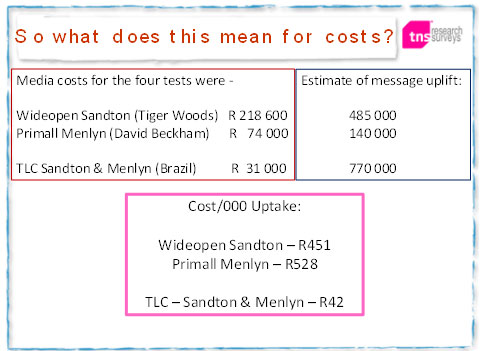
Top stories



This was the result of a series of tests carried out on different Out of Home media in Gauteng in a survey of 1 600 people visiting Sandton City and Menlyn Shopping Center in February and March this year. These results were achieved after an average of only three weeks' flighting and represent only a part of the potential that these four media actually have had the flighting time been longer.
The results of the four experiments were released today by Primedia Unlimited and TNS Research Surveys in a joint statement. "The results show scientifically that people absorb and are able to recall even an arbitrary message in advertising in shopping malls and their surrounds," said Ken Varejes of Primedia Unlimited, who instigated the experiments. Neil Higgs of TNS added, "These were particularly stringent experiments as they used cognitive messages - whereas most brand advertising also works at a deeper, more emotive level. This means that the results, good as they are, are still an underestimate of the media's true potential."
Primedia Unlimited flighted four dummy messages in and around Sandton City and Menlyn Shopping Centre in February and March of this year.
Two messages were in the restrooms of the two centres, these telling people that Brazil would host the 2014 FIFA Soccer World Cup. At each centre, 400 people were interviewed (as they left the centre) prior to the flighting to establish a baseline of knowledge. Three weeks later, another 400 people were interviewed at each centre (also as they left) to establish the message uplift. The results were impressive, especially given the cognitive nature of the message and the short period of flighting:
The other two messages were placed in the malls and the parkades and in a few surrounding roads - and were even more arbitrary:
The results were equally impressive:
The Menlyn results are particularly interesting given that the message had two parts to it - the power of simplicity in OOH advertising is clear.
TNS used its in-home GIS database to geo-code the people interviewed to establish each shopping centre's approximate catchment area. From this, it is possible to estimate the likely actual number of people who are able to recall the message (the message uplift). The results make for interesting reading:

In a completely separate research study with a sample of 2 000 metropolitan dwellers, also in February, people were asked to associate a set if attributes with a variety of media types. From this, TNS constructed a "noticeability index" running from zero to one hundred. OOH media in general scored highly on this index, with large billboards at 61.7 topping the list. In terms of the media used in the experiments, ads inside malls were second on this index, ads in shopping mall parkades were seventh and ads in public restrooms were eleventh. The full results are given below.

These results, impressive as they are, are an underestimate of the three media's true potential since the flighting time was quite short and the message was one that had to be absorbed and recalled cognitively. Further, the Brazil creative was all in capital letters, making it less easy to read. In addition, the experiments attracted some word-of-mouth attention that led to additional discussions on talk radio stations - another spinoff showing the power of content. Gordon Muller has compared the costs calculated with comparable data from Millward Brown and has concluded that the cost per thousand for spontaneous TV ad brand recall is about double that if the Tiger Woods/David Beckham communications.
These experiments mirrored a similar experiment carried out in 1989 by the Cape Town City Council and TNS using messages on the city's buses. These carried a dummy message as well as messages for two brands not then available in South Africa. The fleet of buses used was very extensive and the messages were flighted for three months. They garnered an average message uplift of 24 percentage points or around double the baseline awareness, showing the power of longer flighting times.
For more details, please contact Neil Higgs on 011-778-7500 or 082-376-6312.
Website: www.tnsresearchsurveys.co.za.
TNS is the world's largest custom research agency delivering actionable insights and research-based business advice to its clients so they can make more effective business decisions. TNS offers comprehensive industry knowledge within the Consumer, Technology, Finance, Automotive and Political & Social sectors, supported by a unique product offering that stretches across the entire range of marketing and business issues, specialising in product development & innovation, brand & communication, stakeholder management, retail & shopper, and qualitative research. Delivering best-in-class service across more than 70 countries, TNS is part of Kantar, the world's largest research, insight and consultancy network. Please visit www.tnsglobal.com for more information.
Kantar is one of the world's largest insight, information and consultancy networks. By uniting the diverse talents of its 13 specialist companies, the group aims to become the pre-eminent provider of compelling and inspirational insights for the global business community. Its 26,500 employees work across 95 countries and across the whole spectrum of research and consultancy disciplines, enabling the group to offer clients business insights at each and every point of the consumer cycle. The group's services are employed by over half of the Fortune Top 500 companies. For further information, please visit us at www.kantar.com